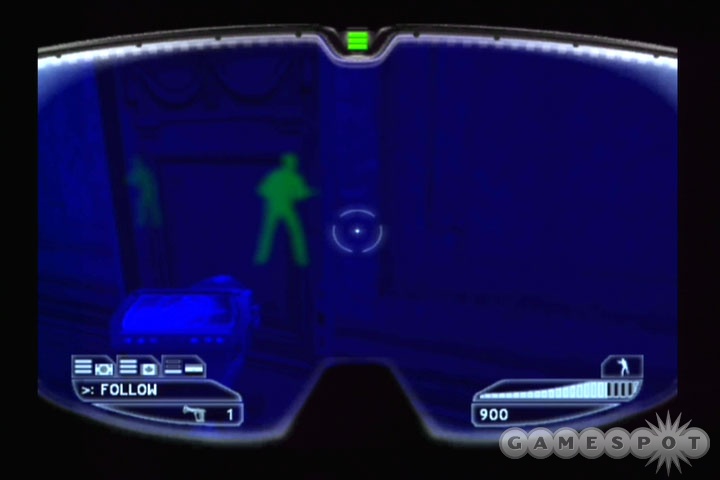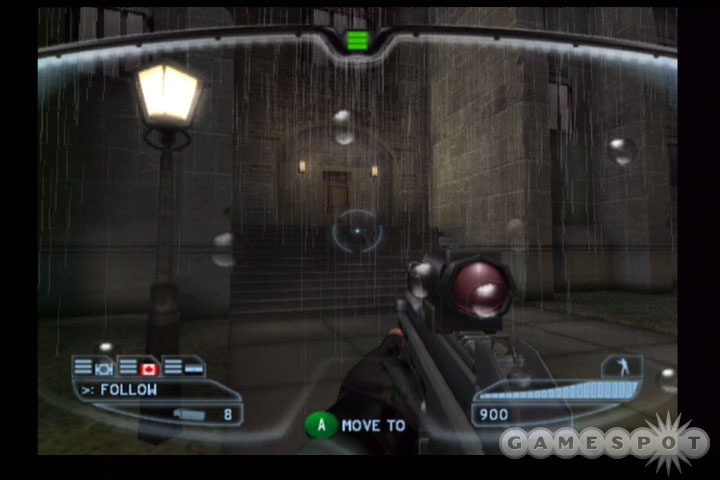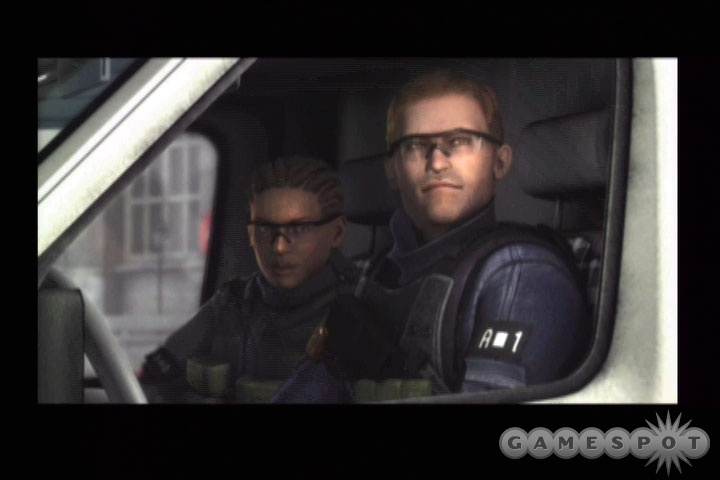While longtime PC players know the original Rainbow Six games as ultrahardcore tactical shooters, the series' transition to consoles has eased the formula, making it more accessible. For the most part, the changes have left the franchise no worse for the wear, growing the popularity of the games while still maintaining some hardcore tactical roots. With the newest iteration, Tom Clancy's Rainbow Six: Lockdown, the series lurches deeper into the arcade realm. Though Lockdown is still a worthwhile shooter, its overall feel may leave longtime fans wondering if the developers have finally strayed too far from the game's roots.

In Lockdown, you're once again put in the shoes of Domingo "Ding" Chavez as you lead small fireteams of highly trained commandoes on dangerous black-ops missions. Backing you up are familiar faces like Eddie Price, sniper Dieter Weber, and the lecherous Louis Loiselle. The game begins with the theft of an illegally produced deadly artificial virus that can wipe out large civilian populations in mere minutes. Lockdown's campaign will take you through 14 missions (16 on the PS2 and GC), spread out all over the world. You'll engage in typical Special Forces operations like terrorist hunts and hostage rescues, but in the end, this all just means you'll wander your way through various buildings, exterminating dozens upon dozens of bad guys.
As in previous Rainbow Six games, room clearing is one of the core aspects of gameplay in Lockdown. You'll approach many locked doors in the game, at which points you can order your three squadmates to stack up by the door, open it, and clear it. If you have the requisite equipment, you can breach locked doors with explosives and/or toss in grenades to make the clearing process safer and easier. For the most part, your artificial intelligence teammates are proficient at doing this and protecting themselves in more open areas. But every now and then they can display a frustrating lack of skill in marksmanship, taking forever to shoot exposed enemies standing mere feet away. Enemy AI in Lockdown is similarly inconsistent. Once in a while you'll see enemies responding intelligently to nearby noise, leaving their rooms to come after you or changing positions to take better cover. But much of the time you can be making a complete ruckus in the next room, and all you'll experience is the doofus in the next room saying "I heard something!" and doing nothing about it. You can sometimes even pick off single enemies in a room by leaning around the wall, and other enemies in the same room will have no visible reaction.

The Xbox version of Lockdown includes a heartbeat sensor gadget (the PS2 and GameCube versions have a similar motion sensor device) that lets you see the position of live enemies (or hostages) behind walls. You can take advantage of this heartbeat sensor every time you come up on a blind corner or locked room. The result is that a lot of the franchise's signature tension and uncertainty is taken away since you can rely on your sensor before opening up any door. This also contributes to a more arcade-like feeling in the single-player campaign--you'll find yourself able, for the most part, to run and gun your way through many of the levels. This still ends up being pretty fun, but the overall feel of the game seems different from past iterations.
One major addition to the single-player campaign is that several of the missions start you off in control of Dieter Weber, the sniper. You'll participate in shooting gallery-style sections in which you'll cover the insertion of the strike team into the mission area, picking off terrorists who are attacking your teammates. Your effectiveness in this portion will affect the rest of the mission, as the healthier you keep the strike team members, the easier it will be to complete the mission. These sniper missions provide a fun change of pace from the usual action, but can also induce some frustrating mission restarts when you take too long to find the RPG guy who just blew up Ding and friends to kingdom come. This isn't too big a deal though, as you can save in-mission at any time on normal difficulty, and the sniper sections come at the start of the missions.
There are some subtle differences between the versions in the single-player campaign. The PS2 and GameCube interfaces make the game even easier, as enemies and other items of interest are prominently called out to you with bright square reticles in the earlier levels. You won't find these in the Xbox version, so you'll need to rely more on tracer fire to track down enemies. You'll also find that certain portions of the levels in the PS2 and GC versions have been simplified, with fewer pieces of furniture in rooms or certain doors and areas taken out entirely. The effects of these changes end up being a lot more minor than they might sound on paper. The interface between the two is mostly the same--the viewpoint offers a slight curvature, as if you're peering through tactical goggles. Raindrops will bead up and slide down your view, and as you take damage, your view will crack bullet holes and go blurry if you're playing the Xbox version, or you'll see a static distortion effect (like Metroid Prime) if you're playing the PS2 or GC version. These are pretty neat effects, if rather nonsensical.

Lockdown makes more of an impact with its multiplayer modes. All versions of the game offer two-player, split-screen cooperative, for both missions and simple terrorist hunts. You can play cooperatively online through Xbox Live as well, with up to four players. The PS2 and Xbox versions also offer team-based and competitive online play for up to 16 players. The PS2 version offers fewer competitive modes, including team deathmatch, the objective-based rivalry mode, and the CTF-like retrieval mode. The Xbox version of the game gives you two team deathmatch modes, retrieval mode, and conquest mode (in lieu of rivalry mode). The online modes in both the PS2 and Xbox versions work well, if you can find a fast server. We did notice some teleporting here and there, but for the most part the games we played worked smoothly, with immediate updates to rankings. The GameCube version, unfortunately, has no online multiplayer.
The Xbox online multiplayer is more interesting than the PS2 version because of its persistent role-playing-game-like element, PEC mode. In this mode you create a character avatar, choosing from four different classes, including commando, medic, spec op, and engineer. Each class has different special abilities, with medics able to heal teammates, engineers able to plant turrets, commandos specializing in heavy weapons, and spec ops able to wield sniper rifles. While class-based shooters are not new, what makes PEC mode interesting is that as you play, you earn credits and experience. You can use credits to unlock new items, weapons, and armor. You'll also need credits to repair your armor and items, which are tagged with durability. Experience lets you gain levels, which in turn gives you skill points that you can assign to upgrade your weapon proficiency or other areas. What's interesting is that the wide variety of areas you can upgrade means more variety in player skill as you level up. As a medic, for example, you could put all your skill points into increasing your healing speed and ability, at the expense of improving your weapon proficiency. Another, more offense-minded medic might choose to do the opposite, gaining in gun accuracy and power while still retaining basic healing abilities. It takes a decent amount of play time to gain levels, and at this point, it's tough for us to judge how well these RPG elements are working. The concept is definitely interesting, though, and you'll have fun deciding which upgrades to get. It's worth noting that if you don't want to participate in PEC, you don't have to; you can still play regular games of Lockdown online on the Xbox without worrying about running into another player 15 or 20 levels higher than you.

Rainbow Six Lockdown doesn't disappoint in its presentation. Each mission is introduced via a slick series of animated/narrated slides that provide context for the operation. You'll then be able to pick out your weapons and loadout from a menu. The menu screens in the Xbox version of the game look particularly polished, with animated cutscenes decorating the background as the game's memorable theme song plays. The in-game graphics are also very nice looking in all versions--you'll find yourself exploring fairly large areas and buildings. There are some hiccups with character animation, particularly if your AI teammates bump into one other as they stack near a door, but for the most part everything looks great and runs smoothly. You'll find a decent amount of voice acting in the game as well, and the cutscenes attempt, for better or for worse, to give each character some personality. There isn't much music in-game, but when the score does strike up, it adds a good deal of atmosphere to a soundscape dominated by orders, yells, and crisp gunfire.
Lockdown feels in many ways like a Top 40 pop album. All the polish and the basic elements are there to make it a great product, but it seems to lack a soul. You'll probably get some mileage out of multiplayer, which is as frenetic and enjoyable as you can expect from a game of this nature, especially co-op play. But the single-player gameplay doesn't hold up its end of the bargain quite as well. Tom Clancy's Rainbow Six: Lockdown rides that precarious border between tactical and arcade, and while still fun on the whole, it probably doesn't address either side as adequately as it should.